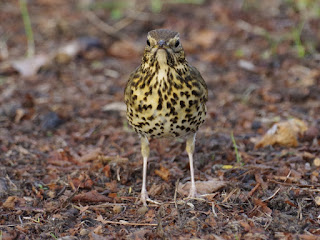Another frosty night had brought ice to the Long Water, and some Black-Headed Gulls were standing around nonchalantly on it.
The Serpentine, though more exposed, is less prone to freezing because the wind makes waves on it. Some Cormorants were busy fishing near the bridge, but not catching much because they have eaten most of the fish.
It was a three-owl day, a rare thing in midwinter. The female Little Owl in the chestnut tree by the leaf yard was out on a branch, idly stretching a wing.
The male owl near the Albert Memorial was looking out of the hole in the oak tree.
And the male in the lime tree on Buck Hill was in his usual place just outside the pair's new hole.
The fruit is now almost completely gone from the rowan trees on Buck Hill, though a Goldfinch had found a solitary berry.
Mistle Thrushes were picking up fallen fruit from the ground.
A Redwing was looking down from a nearby tree. It may have been frightened by the Mistle Thrushes, but I think it was waiting for me to go away before it came down and started foraging.
This Song Thrush was to the west of the Parade Ground.
There used to be a colony of Song Thrushes on the Parade Ground before it was turned into a more or less permanent building site. Some of them retreated to the south end of the central reservation of Park Lane, which is noisy and polluted but inaccessible to humans.
A Robin was looking remarkably inconspicuous among fallen leaves.
Many bright coloured birds are well camouflaged. The important thing is the colour scheme should be disruptive, hiding the shape of the bird.
One of the 'Polish' Mute Swans was stepping carefully down the slippery edge of the Serpentine. You can see its pale legs and pinkish bill.
Most swans with this colour mutation are female, because it is sex-linked. In birds it is females that usually have sex-linked characteristics, because their sex chromosomes are the reverse of those of mammals. Male birds have two Z chromosomes and females have a Z and a W. Thus in females, any defective gene in the Z chromosome is expressed, while in males the other Z usually covers the deficiency and the bird is normal.
A female Egyptian Goose was standing on an urn in the Italian Garden making a tremendous racket and flapping. It can't be thinking that this is a possible nest site. They just like standing on things and displaying.
A pair of Gadwalls in the neighbouring pond were quietly getting on with things. You hardly ever hear them quacking, unlike noisy Mallards.













It was cold today! Great pictures!
ReplyDeleteI've always thought Redwings look angry!
I wonder whether it can change those fiery eyebrows or not..
They don't sound fierce when you hear them. A very mild and gentle chatter.
DeleteI don't know if it is the same with Redwings, but Mistle Thrushes have quite a reputation as plucky birds here. I have never seen it myself, but our field guide insists that they will stand up to owls and magpies and even ravens.
DeleteThat Robin could very well feature in a game of Where is Wally?
Mistle Thrushes are fierce defenders of their nests and will attack Carrion Crows or Magpies that come too near, flying repeatedly over their heads and bashing them as they pass while rattling furiously.
DeleteWe had a friend with a berried bush in the drive which mistle thrushes defended for food. Anyone entering the drive was attacked and the postman refused to deliver.
DeleteOh, wow, how wonderful! There are so very few of them here that for me they are something of a rarity. I think I'd take residence near the berry bush just to be attacked by the Mistle Thrush. Are they as vicious to postmen as the famous Australian magpies?
DeleteA notice at the front gate saying 'Beware of Thrushes' would be a fine sight.
Delete